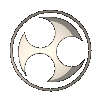
June 11th, 2006
From Kyoshi Baker, Ueshiro Midtown Karate Dojo
Target: solar plexus
Our
three primary frontal targets - nose, solar plexus, and
groin - are all
located on the midline of the body. They are each 1) convenient
- the midline
is the easiest to hit during a moving, dynamic fight (and
a near-miss will
still usually impact the lateral area of the same body part),
and 2) neither
bodybuilding muscle nor body fat amass at these three points
which could
safeguard
them from attack.
Of the
three, the most popular one in our kata, the solar plexus,
is ideal in
it's own right because 1) its height is within reach even
if the person is
much taller or much shorter than we are, and 2) it is more
difficult for our
opponent to body shift it out of the way, to avoid our attack,
than is the head.
The
solar plexus (also called the celiac plexus or c?liac plexus
or
epigastric plexus), in addition to being located on the
midline when viewed from
the
front, is also located in the center when viewed from the
side. (Halfway between
the front and back.)
You
can reference the Gray's Anatomy book for this information,
or find it
online at http://bartleby.com/107 or http://education.yahoo.com/reference/gray.
Therefore,
it is approximately five inches behind and slightly below
the
xiphoid process of an adult male. Consequently, for a technique
at the solar
plexus to be effective, we must get the shockwave of our
attack as deep into the
body as possible. (Our fist won't actually reach the nerve
center of course, but
the force of our technique must.)
See
http://education.yahoo.com/reference/gray/illustrations/figure?id=838
for
the location of the solar plexus (again, sometimes listed
as "celiac plexus.")
To understand
the effect of an attack on the solar plexus, you can view
http://education.yahoo.com/reference/gray/illustrations/figure?id=839,
which
shows
the various organs that are controlled through it. In addition
to those
listed, the diaphragm, which controls our breathing, is
located directly above
it.
Note too that the smaller nerve centers in the torso are
closely connected to
the solar plexus and therefore affected as well.
Related
to trauma to the solar plexus, there are several stories
of
accidental deaths that have occurred from strikes to the
chest, such as youths
being
struck by baseballs or other objects, and a Medford, MA
cheerleader who died
when she hit the ground with her chest, was conscious at
first, mistakenly
thinking that she merely had had the wind knocked out of
her.
So the
solar plexus is an excellent target. This nerve center controls
the
cardiorespiratory system.
1) A
strike here is extremely painful and can temporarily stop
one's
breathing. 2) A powerful strike can cause unconsciousness
from neurological
shock to
the autonomic muscle, the diaphragm, that produces our breathing;
from
neurological shock to the nearby organs; as well as by slowing
the heart's
functioning
by constricting the blood flow in the body's largest vein,
the inferior vena
cava, from the body back into the heart's right atrium.
3) And a penetrating
blow can, in addition, damage the integrity of the internal
organs themselves.
You
just have to hit hard, through the xiphoid process at that
slightly
downward angle that Hanshi describes ("bead of oil")
at
http://www.shorinryu.com/tec.library/t081098.htm, and deep:
always accelerating
through the point of
contact.
Domo
arigato gozaimasu,
Kyoshi David Baker
From Columbia University Press:
http://www.answers.com/topic/solar-plexus
"solar plexus: dense cluster of nerve cells and supporting
tissue, located
behind the stomach in the region of the celiac artery just
below the diaphragm.
It is also known as the celiac plexus. Rich in ganglia and
interconnected
neurons, the solar plexus is the largest autonomic nerve
center in the abdominal
cavity (see nervous system). Through branches it controls
many vital functions
such as adrenal secretion and intestinal contraction. Popularly,
the term
"solar plexus" may refer to the pit of the stomach.
A blow to that area, if it
penetrates to the true solar plexus, not only causes great
pain but may also
temporarily halt visceral functioning."
See
also, Sensei Joe Knight's Nov. 24, 2003 Technique on chudanzuki
at:
http://www.shorinryu.com/thought.library/tho112403.htm
And "Solar Plexus Impaction" at http://www.chiro.org/rc_schafer/mono-21.shtml
